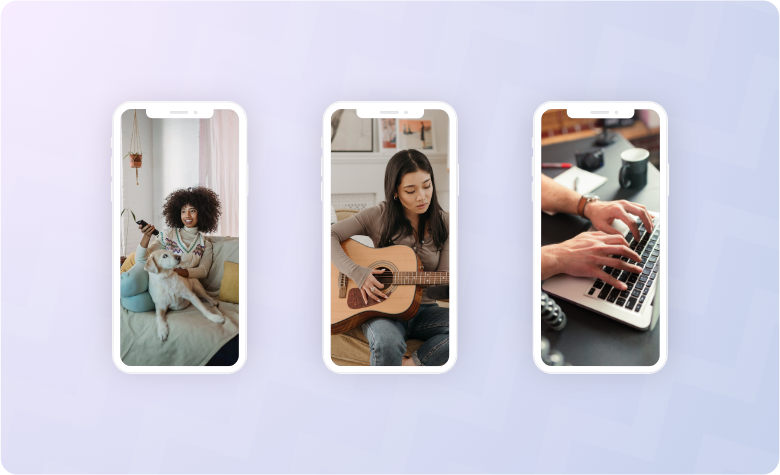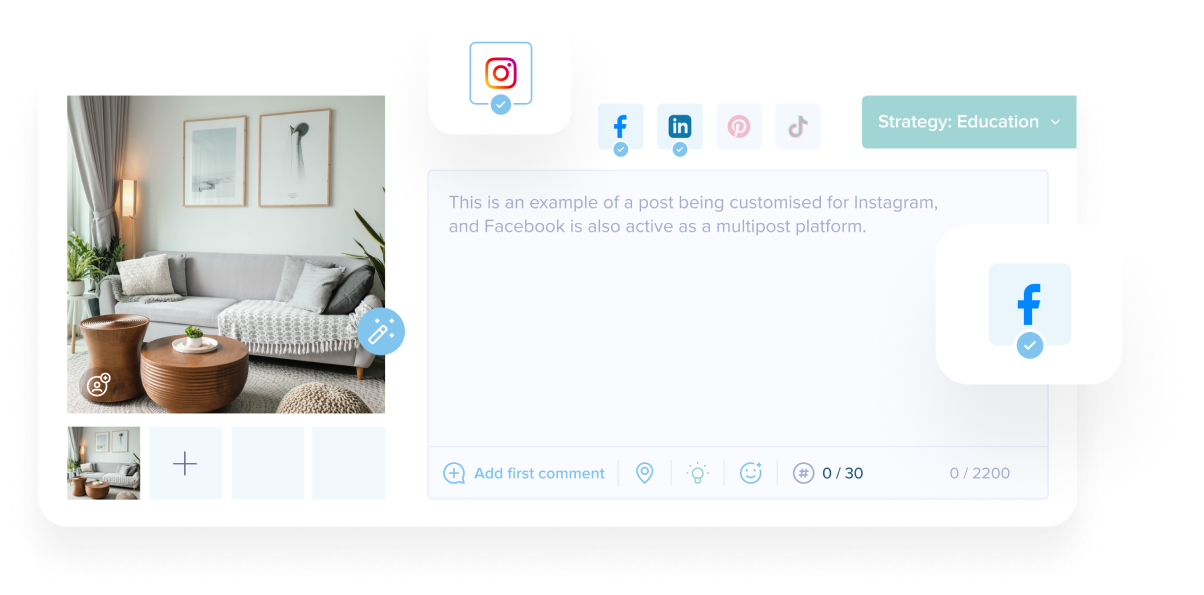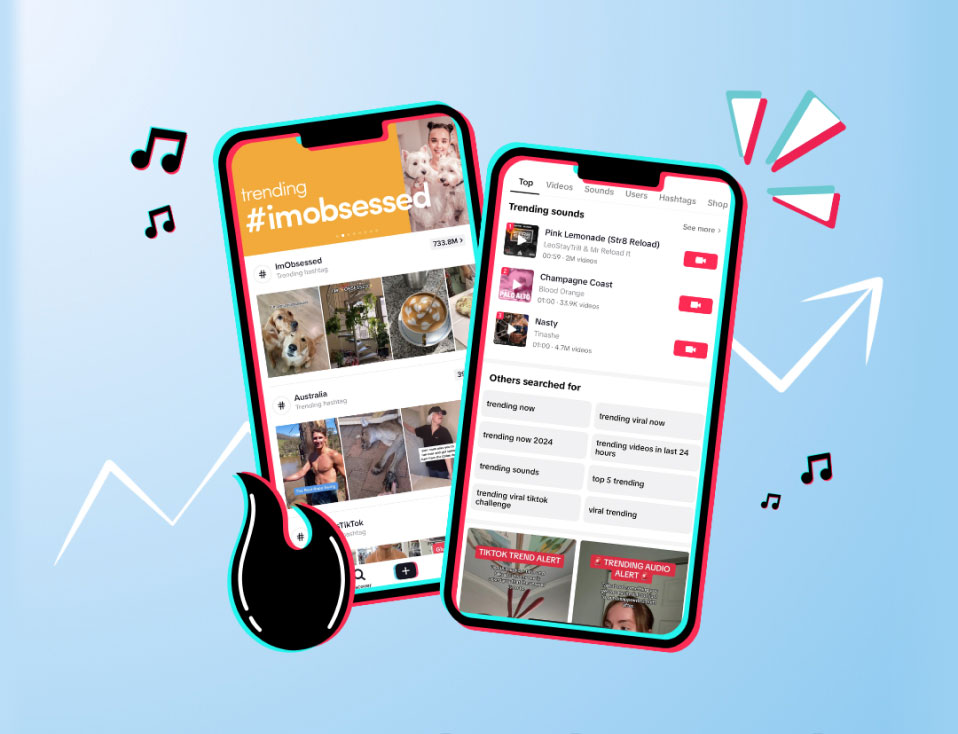Video content has been the darling of marketing for several years, and it’s only getting more important. Creating videos for your business is essential, but it takes time, resources, and creativity. This means you need to make the most of every video you produce.
Do you want to create more high-quality video content but feel like there aren’t enough hours in the day to do everything?
Maintaining a consistent social media schedule is a lot of work, from filming to editing and writing captions, unless you know how to work smarter, not harder.
That’s where repurposing your long-form or short-form video content can change the game.
Using your “hero video”, you can create multiple pieces of content, reach more people, and increase your chances of going viral.
And you can achieve all that without creating new content every day or even every week.
What is Repurposed Video Content?
Repurposing video content is the process of converting existing video content into different formats. It helps you get additional value from your videos without starting the content creation process from scratch.
For example, you could repurpose your YouTube videos and splice the most shareable moments up into short-form videos for Instagram Reels or TikTok or transcribe the video into a blog post.
Why You Should Repurpose Your Long-Form Video Content
Create More Content. Faster.
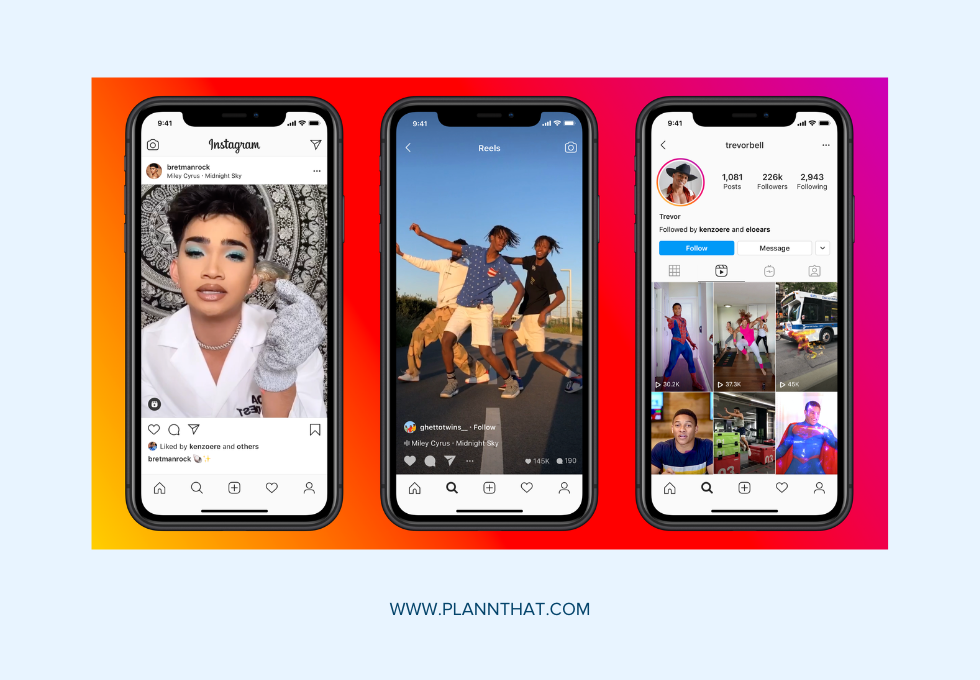
It’s no secret.
Creating content, especially high-quality content, takes a lot of time.
And that’s the one resource you can’t make more of.
So, you need to figure out how to work smarter, not harder.
Enter: repurposing long-form video content.
You’ll get a ton of short videos to use on socials (in 30 minutes or less) without having to create each one from scratch.
Say goodbye to constantly working on new content!
Benefit 1. Reach a Wider Audience
Your target audience isn’t only on YouTube.
There’s a high chance your potential customers are more active on other social media platforms like Facebook, Instagram, Twitter, Instagram, TikTok or LinkedIn.
When you take your existing content and push it out onto other channels, you automatically increase your reach and expose your brand to new audiences.
Benefit 2. Increase Your Views and Engagement
You can’t only rely on the YouTube algorithm and your subscribers to bring in the views.
By sharing bite-sized clips from your podcast or YouTube channel to other social platforms, you’re driving social media users to check out the full-length original video, increasing your views, subscriber count and AdSense check.
Bada-bing!
Why is Repurposing Video Content a Good Idea?
Getting more from each piece of content is worth the hype. Here’s how it can help you achieve your marketing strategy goals.
You Can Reach More People
One of the biggest benefits of repurposing your content is that it helps you reach a wider audience on multiple platforms.
Let’s say someone is your ideal customer but doesn’t follow you on YouTube. While on TikTok, the person stumbles across one of your videos, starts engaging with your content, and eventually makes a purchase.
If you didn’t have a presence on TikTok, you would have missed out on reaching potential customers and limited your reach to only one platform.
You Save Time on Content Creation
Content marketing (and marketing in general) is a numbers game.
The more pieces of content you have floating around the Internet, the higher your chances of going viral and attracting the right audience to your brand.
However, it’s a lot of work to create and publish multiple content types across different platforms every month (especially if you’re a solo-preneur, a content creator without a team or working a 9-to-5).
With content repurposing, you create your hero piece of content (e.g. a YouTube video) and use it to spawn 54 new pieces of content.
Incredible, right?
It reduces the time you need and helps you maintain a consistent posting schedule with less effort.
You Can Improve Your Organic Search Traffic
Google. YouTube. Pinterest.
These are the biggest search engines in the world.
What about TikTok and Instagram? Those platforms aren’t far behind.
In fact, TikTok is the most popular search engine among Gen Z. Nearly 40% prefer it over Google to find information.
Now, if you’re only relying on Google to bring in traffic to your business, you’re missing out on the millions of monthly searches on all the other social media channels.
Plus, you’re fighting to get your content seen on the first page of Google. Getting your content to rank on YouTube or Pinterest is much easier, where there is less competition. This is a way to “steal” traffic from bigger websites with a stronger domain authority—a key ranking factor.
And there’s more.
Google indexes and incorporates YouTube videos and TikTok videos into search results. While your blog post on the “benefits of green smoothies” might struggle to rank on the first page of Google, your repurposed content might rank higher on the “Videos” or “Images” tab.
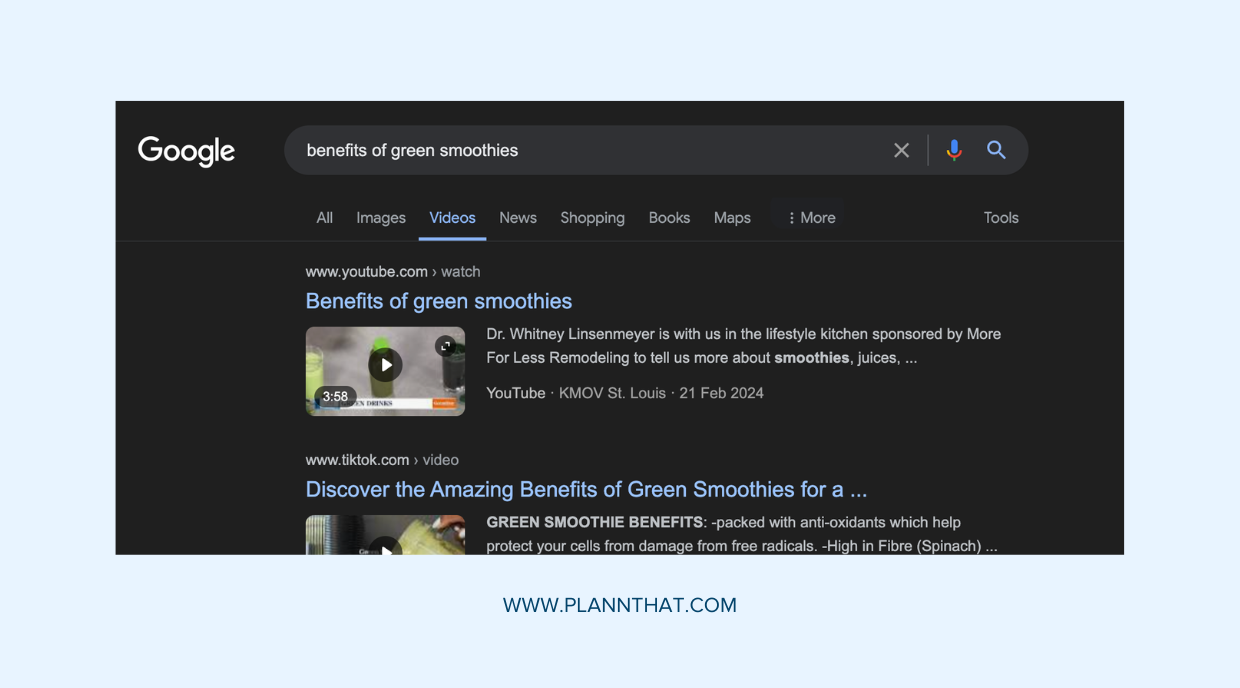
As you can see, the top results for the same search term but different content types on Google aren’t from the same creators or websites.
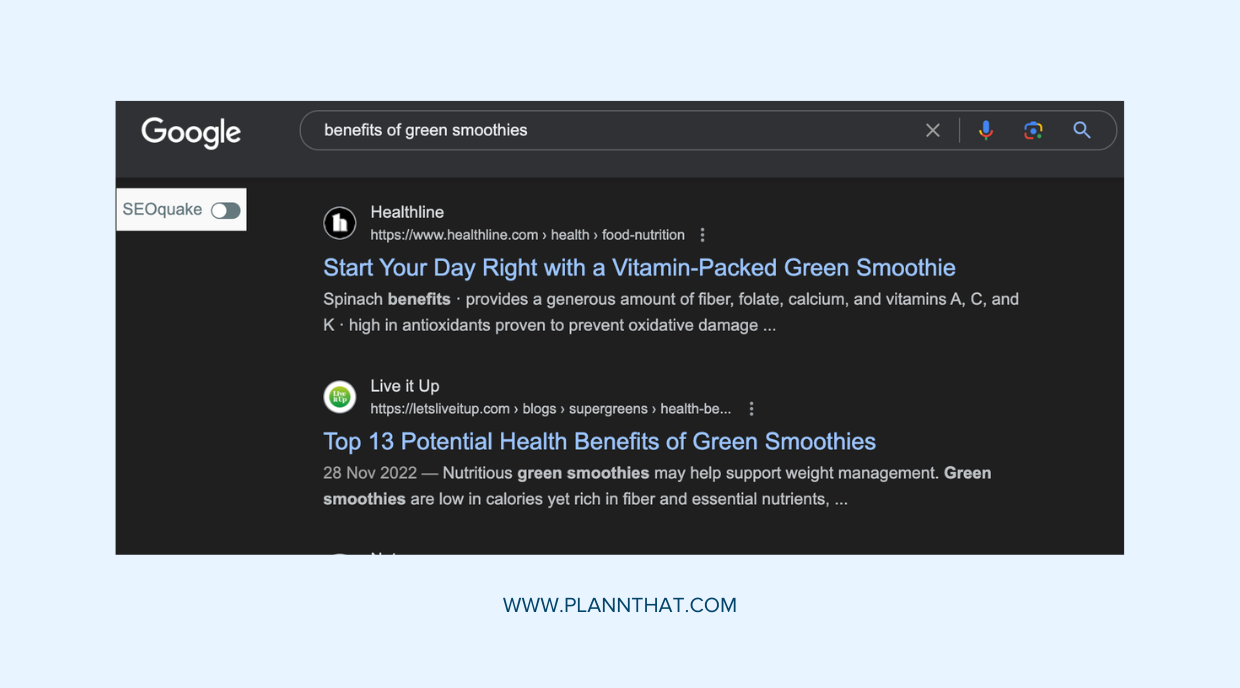
How to Repurpose Video Content in 3 Easy Steps
Discover how to effortlessly extend the life of your videos and grow your audience online.
Step 1: Examine Your Existing Video Content and Create Your Video Bank
The first step in repurposing video content is to get a handle on your current video assets, a.k.a. your video bank.
If you’ve been creating content for a while, you probably already have evergreen YouTube videos, TikToks, Instagram Reels, webinars, etc.
Some of these videos might be okay to splice up and turn into new pieces of content as is, while others might require a refresh.
For example, some information might need to be updated, or your supporting assets are no longer relevant.
The main goal is to identify what needs to be re-recorded or re-edited and what videos you can repurpose into social media posts or other content types right now.
💡 Plann Tip: Create a spreadsheet or use a Notion template for your video bank to keep track of all your video assets and the status of each one.
Step 2: Choose Your Content Formats and Social Media Platforms
Now that you have your video content bank, it’s time to decide how to repurpose it and where you want to post it.
Not sure where to begin?
Here’s a quick guide on how to choose your formats and platforms:
- Who is your audience? Go on an audience deep dive. Uncover their demographics, biggest pain points and how you can align your messaging with their needs.
- Where does your audience consume content? Once you have a clear idea of your target audience, you’ll want to align your content strategy to their preferences. For example, if Gen Z is your largest customer base, you’ll want to focus on platforms like TikTok and YouTube over X and Facebook.
- What are your resources? Do you have a budget to outsource content creation, or does it depend on how much you can create? Do you have the ability to create gated content like swipe files or ebooks? If yes, would it add value to your audience and marketing funnel, or are you just ticking a checkbox?
Using your answers as a guideline, let’s look at some examples of repurposing video content into different formats:
Long Form Videos into Clips for Reels, TikTok and YouTube Shorts
If you’re creating YouTube videos, webinars, or a video podcast, repurposing your videos into short clips for social media is a no-brainer.
It helps you capture dwindling attention spans and entice social media users to check out the full episode or video.
Vanessa Lau is a master at repurposing her existing content across multiple channels.
View this post on Instagram
She’s clipped this moment with the hook “Don’t Be a YouTuber” and posted it to Instagram Reels. It grabs attention to get users to start watching, and she follows it up with a call-to-action in the caption to watch the full YouTube video.
YouTube Videos in Blog Posts and Email Marketing Blasts
Don’t have the time to write out your YouTube videos?
You can use a tool like Notta.ai to quickly convert your video content into text. Once you’ve done this, you can upload it straight to your website and format it for SEO.
Some tweaks may be necessary, but it’s a solid game plan for creating new blog posts – fast.
One creator who uses this strategy is Elise Darma. She creates her YouTube videos and then transcribes them for her blog, editing the text to ensure it’s optimised for search.
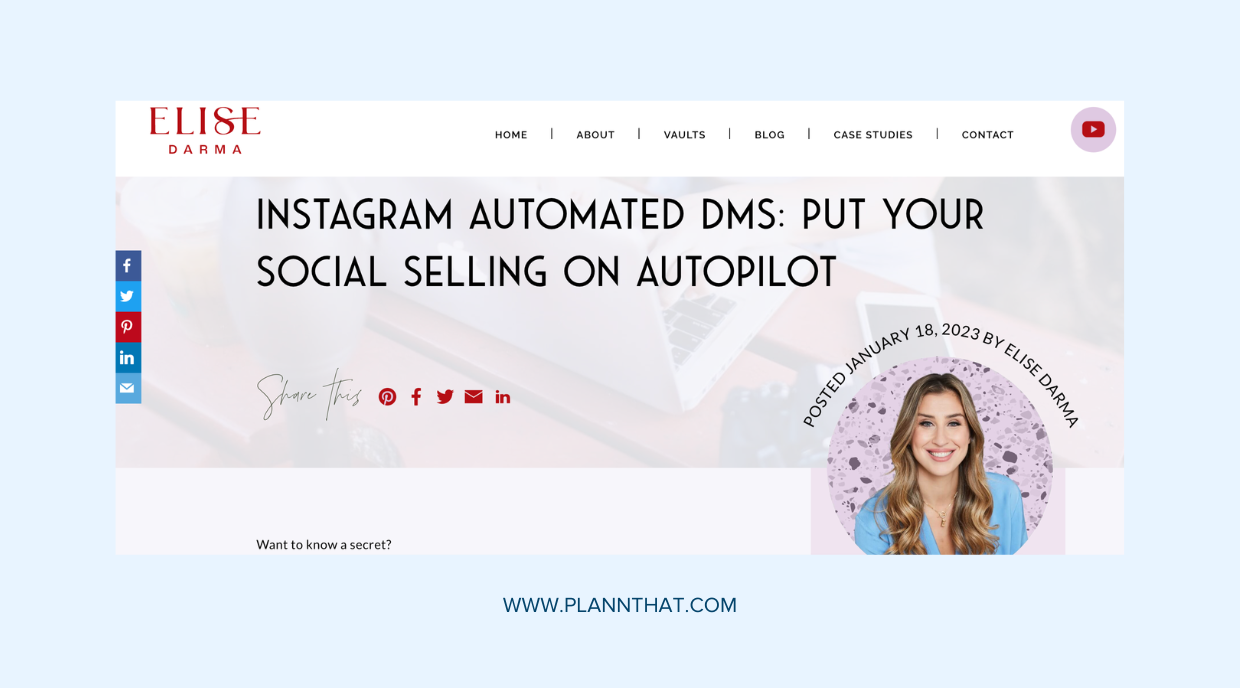
That’s not all.
Elise also turns her YouTube videos into clips for Instagram Reels and reposts them on TikTok. She also uses the video as a topic for her weekly newsletter.

Step 3: Create and Schedule Your Content
With your repurposed video content strategy in place, it’s time for the fun part – creating!
One of the best methods for overcoming the workload is to use task batching and block out non-negotiable time in your calendar.
Let’s say you want to repurpose your two long-form videos and turn them into short-form video clips for TikTok and Instagram.
Set aside time to first pull out the clips you want to use from your existing videos and adjust the dimensions for each social media channel. For example, you would need different resolution sizes for Instagram Stories, TikTok, or LinkedIn posts.
Then, add subtitles, write captions, and finally, schedule everything into your content calendar. With Plann’s Cross Post tool, you can create and post a single post across multiple social media networks at the same time, all in one step!
You can repeat this process with any other content types you’d like to create.
Why does this method work so well? It prevents context switching, which fatigues our brains. When you switch between apps and tasks, it takes an average of 9.5 minutes for your brain to adapt to a new context.
By focusing on one type of task at a time, you can improve your productivity and create better content – faster.
Why is Repurposing Video Content a Good Idea?
Getting more from each piece of content is worth the hype. Here’s how it can help you achieve your marketing strategy goals.
You Can Reach More People
One of the biggest benefits of repurposing your content is that it helps you reach a wider audience on multiple platforms.
Let’s say someone is your ideal customer but doesn’t follow you on YouTube. While on TikTok, the person stumbles across one of your videos, starts engaging with your content, and eventually makes a purchase.
If you didn’t have a presence on TikTok, you would have missed out on reaching potential customers and limited your reach to only one platform.
You Save Time on Content Creation
Content marketing (and marketing in general) is a numbers game.
The more pieces of content you have floating around the Internet, the higher your chances of going viral and attracting the right audience to your brand.
However, it’s a lot of work to create and publish multiple content types across different platforms every month (especially if you’re a solo-preneur, a content creator without a team or working a 9-to-5).
With content repurposing, you create your hero piece of content (e.g. a YouTube video) and use it to spawn 54 new pieces of content.
The Best Tools for Repurposing Long Form Videos
It’s a lot easier to create short-form videos than you think.
There are dozens of tools that can help you quickly repurpose a full video and turn it into bite-sized snippets resized for most social media platforms.
1. Descript
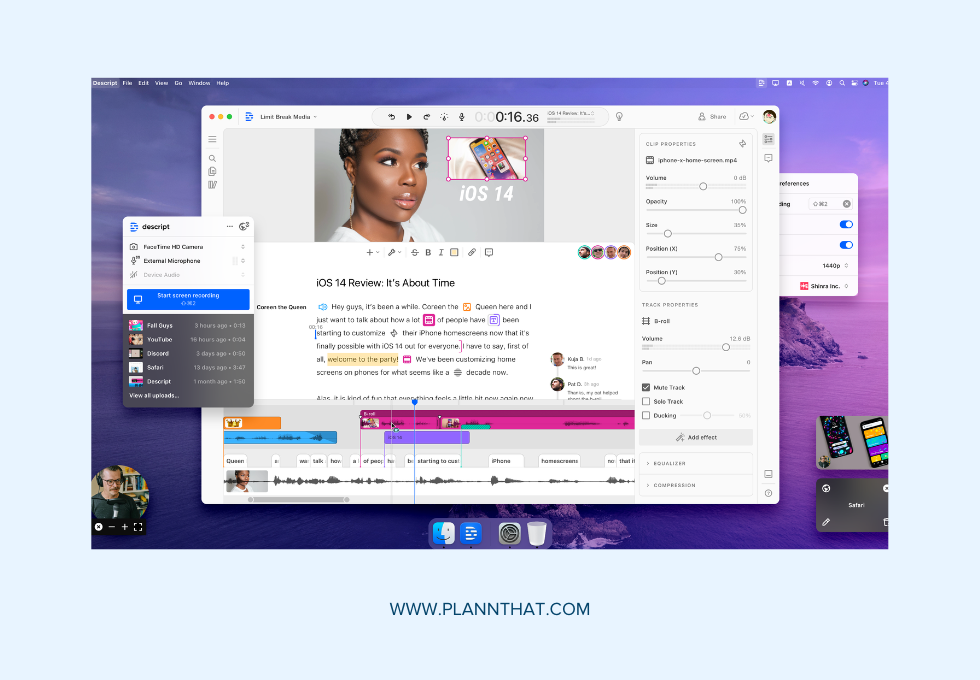
You could download an app like Adobe Rush and splice up your original video, but there is a better, much easier way.
One that doesn’t require a learning curve or the struggle of trying to cut out all your filler words.
Descript is a two-for-one editing tool.
1. It helps you edit videos for social media quickly.
2. It transcribes your entire video at the same time.
Why is that the deal of the century?
Because not only can you create multiple short videos, but you can take the text and turn it into a blog post.
…And that’s not all.
Descript is different from your run-of-the-mill editing software in one crucial way.
You don’t edit the video. You edit the text.
Simply select the clip highlights you want to include in your video and delete any text you don’t want to include. The AI software does the rest.
It’s the least frustrating way to filter out all those “um’s”, “you know’s”, and “like’s”.
Throw in some dynamic text, waveforms, or progress bars to make your video content more visually engaging and export to your device or the social media platform of your choice.
Price: Free with paid plans starting at $12 per month
2. YouTube Shorts Editing App
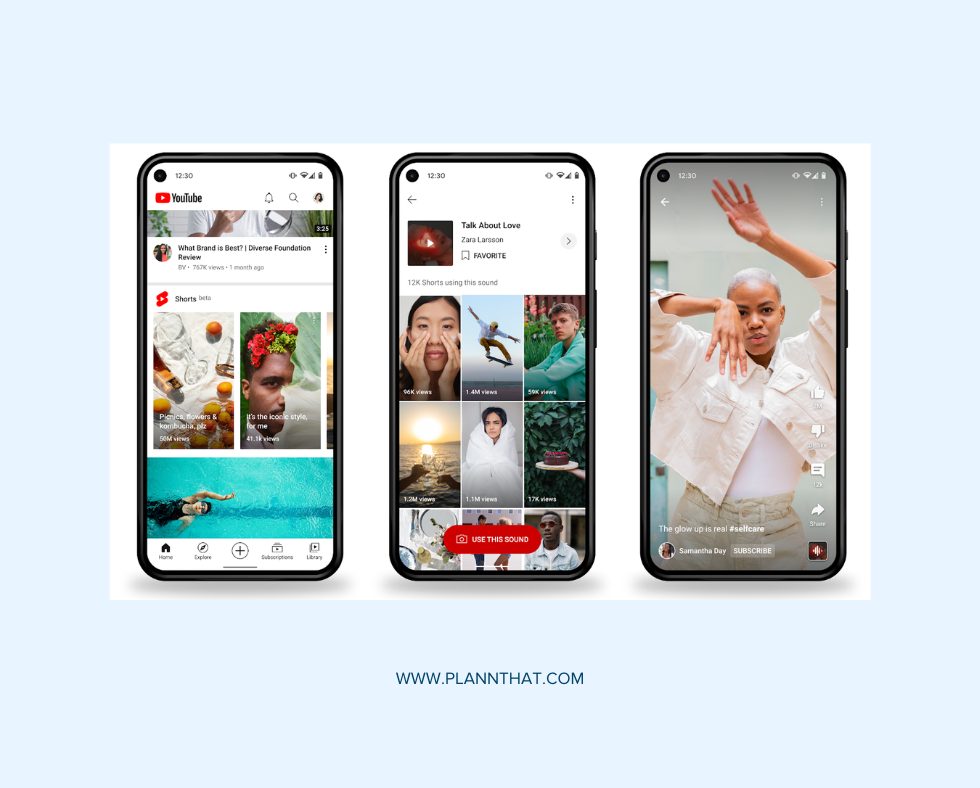
Do you already have YouTube videos on your channel?
The good news is that you don’t need to dust off your old hard drive to look for your original final edits or re-download each one onto your laptop.
All you need is the YouTube app.
Open it, navigate to your video of choice, and you can automatically import it into the YouTube Shorts interface and start creating clips of your content.
You’ll have access to a full range of creation tools with the same basic editing tools you’ll find on TikTok and Instagram Reels.
The only downsides?
• YouTube shorts are restricted to 60 seconds.
• You must manually download each video clip to share it on other platforms.
• You’re limited to the editing suite’s colours and fonts, which might be problematic if you want a cohesive brand look.
Price: Free
3. Pictory
Here’s the thing.
You’re busy.
You’ve already spent hours planning, filming, and editing your long-form video.
And sitting down for a second editing session on top of all the other tasks on your plate?
It’s a hard sell.
That’s where Pictory can help.
The AI video editing software automatically finds those “golden nuggets” in your YouTube, webinar or podcast videos. Then, you can fine-tune what you want to include in your final video and share it on your social channels.
Plus, Pictory adds accurate captions to your videos without you having to lift a finger, helping reach the 85% of social media users who watch on mute.
Price: Paid plans start at $23 per month.
4. Munch
Want to kick the AI video editing up a notch?
Give Munch a whirl the next time you need to repurpose video content.
The platform uses its advanced machine learning capabilities to automate editing, caption creation and finds the best clips with the highest potential to trend on social media.
How?
Based on the latest marketing insights and trend analysis, its algorithm will scan your video for topics, theme and context and generate video clips for TikTok, Instagram, Twitter, LinkedIn, and YouTube Shorts.
While it is the most expensive option for repurposing video content, it’s worth it if you want to use the power of AI to go viral and boost your brand exposure.
Pricing: Paid plans start at $49 per month.
8 Ways You Can Repurpose Your Video Content
If repurposing sounds daunting, it shouldn’t. It can be done quickly, easily, and doesn’t need to be a tricky task (even if you’re a video content newbie!). Here are just a few ways to turn one video into multiple pieces of content.
1. Transform your video into a blog post
From an SEO perspective, updating your website regularly with written content is vital. Having video content on your site is equally crucial. But did you know the blogs with the greatest potential to rank are those presented in multiple formats?
Google (and other search engines) always try to present users with multiple formats that answer their search queries. Yes, they often show users blogs and static, written content. But they prioritize sites that also give readers multimedia options.
So, if you’re blogging, having a video version of your blog is the single most powerful thing you can do for your SEO. And if you’re already creating video content, transcribing that video and uploading the transcript with the video is an absolute no-brainer.
You will also gain brownie points on YouTube (which is the second-largest search engine next to Google and owned by Google) if you upload transcripts or captions of your video to the platform.
Bonus tip: make sure you’re leveraging this blog post across all of your social channels with link preview posts and dynamic carousels breaking down the key points on Instagram.
2. Create a podcast episode from your video
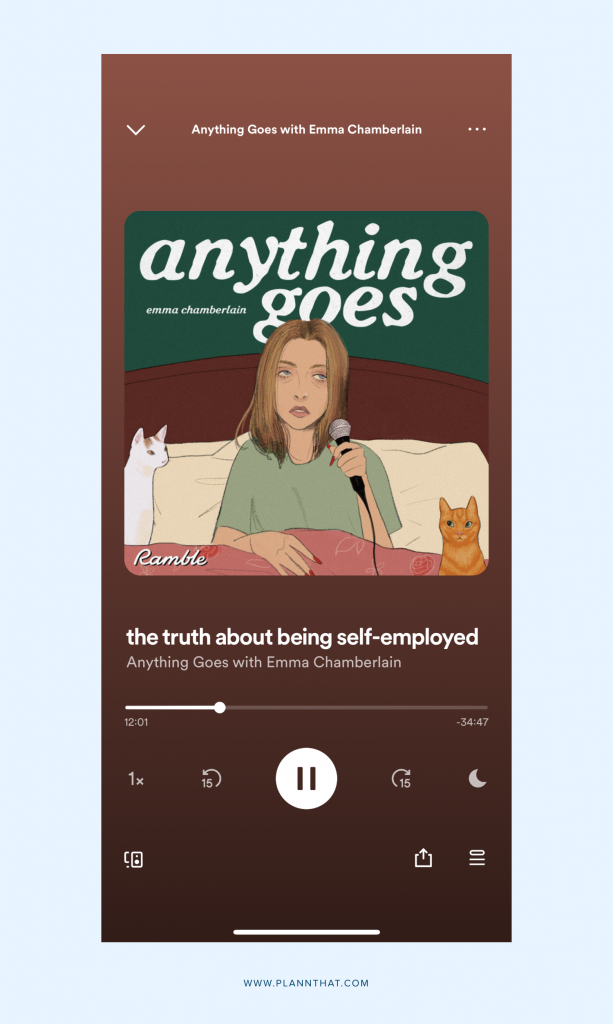
If you don’t already have a podcast, think about starting one. Audio, like video, is increasingly popular. Audiences don’t always like to read, or don’t have the time. The audio format can be absorbed in your audience’s daily commute, while they walk the dog, do the dishes, or work out at the gym.
And, just like adding a video to a blog makes the blog more powerful, so does an audio version.
Remember, search engines love multimedia!
The best bit? Podcasts are a brilliant content format to share on social media. Whether your use a link sticker on Instagram Stories or share a post to your LinkedIn page, there are endless ways to amplify your podcast content to build your presence on social media.
3. Create Pinnable infographics
Speaking of multimedia, when you’re uploading your video to your website ensure you create an eye-catching cover image (usually a photo or graphic with the title) in your branding. Then, create a board on Pinterest (another massive search engine) and pin all your posts to it.
While you’re at it, adding additional images that are worthy of pinning is a great way to drive traffic to your website and increase your reach. Can you create an infographic that conveys the core information or message of your video? If not, how about a nicely designed quote?
There’s no limit to how many images you can create and pin on Pinterest, with a link to your video on YouTube or your website, so don’t be afraid to pack in those backlinks! Optimize them further with short descriptions and relevant hashtags and you’ll soon have people repinning and spreading your content.
4. Amplify your video content on Pinterest
While we’re on the subject of Pinterest, the platform now supports short-form video content. Find a snippet or two from your video that works well alone, and is visually appealing, and save these clips as separate videos. Pin them along with your cover images and infographics.
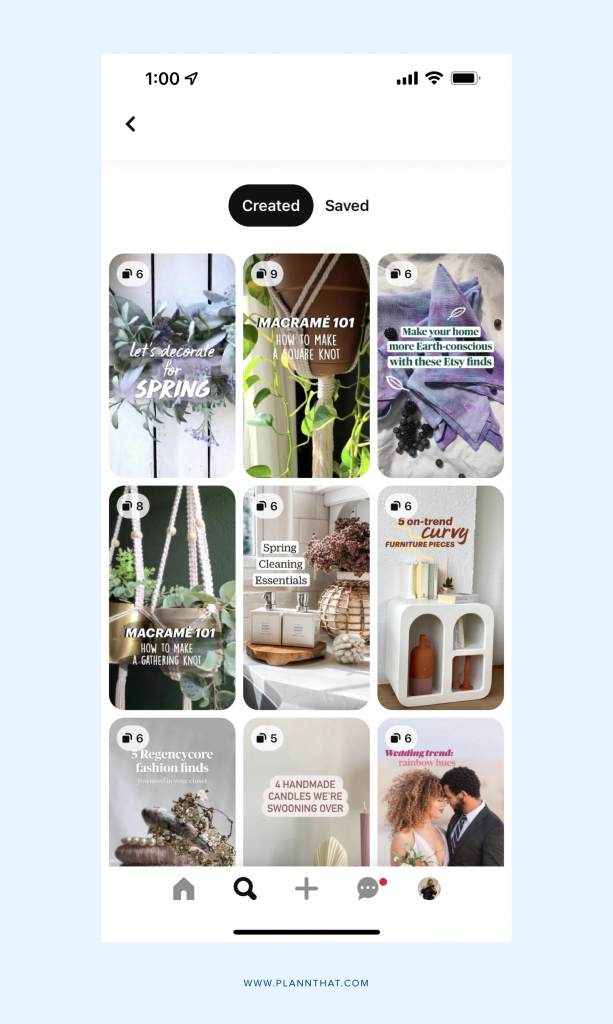
5. Create a LinkedIn article
Once you have the transcript of your video to create a blog post for your website, create a LinkedIn thought leadership article and share it with the business community.
Upload the full article directly to LinkedIn, or find a suitable stop point and end it there with a call to action to keep reading on your website, or watching on YouTube.
6. Quora answers
Similarly, creating answers on Quora using the content from your video can be hugely beneficial to your SEO. If your content answers questions, search for threads relating to those questions and post the relevant sections of your video transcript in response. Don’t forget to link to the full video so people can find more information.
7. Produce short video snippets
Go through your video and cut out a load of short snippets. These might be a couple of sentences of useful information, a vital tip, a piece of trivia, or pose an intriguing question.
You can use these as Tweets, with a link back to the full video for more information. You can also post them as TikToks and add a link to the full video in your bio (use LinkTree to add multiple links on a single URL).
Make sure to experiment with different video dimensions (such as vertical cuts along with classic square sizing) to ensure your video content performs well on a range of platforms.
8. Reshare a video on Instagram
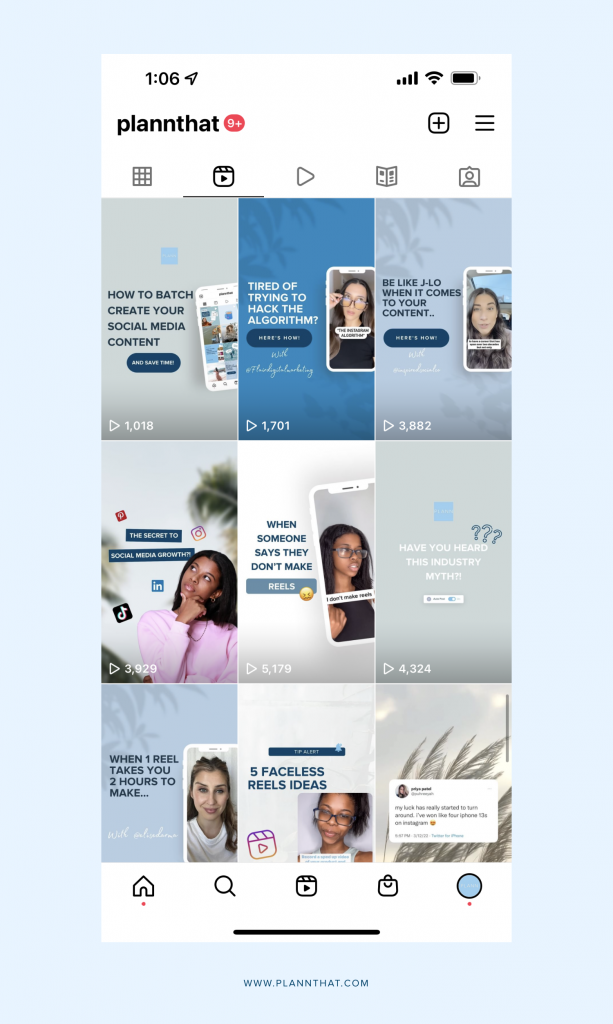
There are endless ways to share video content on Instagram. The first is to simply upload it to Instagram in its full form. This used to be called IGTV, but a recent update saw all videos (aside from Reels) merged into a single video section on your profile.
Instagram is shifting in favor of video as its main format. Instagram has always been dominated by images, but now, the platform is encouraging people to only post three images per week, while posting multiple videos in various formats on a regular basis.
There are several ways to share short snippets of your video on Instagram:
• Format short snippets of your video in 1080 x 1080 squares and post them to your grid.
• Create Reels from clips of your video (make these 1080×1920).
• Share brief clips (5-10 seconds) from your video as Stories, and let people know where they can watch the full version.
Repurpose your video content with Plann
One of the huge benefits of repurposing is that you can create content for several days, or even a week, quickly and easily. Once you have all the files and content ready to go, you can simply schedule each post in advance.
Save even more time by creating and sharing a single post across multiple social media networks at the same time, all in one step with Cross Posting.
This has the advantage of ensuring you don’t forget to post when the time is right. It’s also far less time-consuming to batch schedule content than it is to try and prepare your content daily.
Ready to streamline your reposting strategy? Sign up for a FREE 7-day trial of Plann and use our content calendar, cross-posting tool, and AI-caption generator to help you achieve your social media goals.
